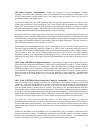23
13.4 Measuring Harmonic Levels – With the amplifier still putting 2.5 watts at 1000Hz into the 75
ohm dummy load resistor, enter a frequency of 2000Hz using the HP3586’s keyboard to change it’s
measuring frequency to 2KHz. You should see a lower than 0dbm reading on the level display. If you
have trouble finding it go to a wider filter and then back to the 20Hz filter after tuning it in. Let’s say it’s –
24db but we are not really sure that maybe the signal generator’s frequency has not shifted a few Hz.
Because we are using only a 20Hz filter to reduce noise errors, we have to get right on the harmonic’s
frequency to get an accurate reading. Use the counter feature to lock the instrument to the harmonic. Say,
the display now reads –20.06db, indicating the second harmonic is -20.06db, about 1/100 of the power of
the fundamental frequency power, not bad about 1% of the fundamental’s power.
We can now search out and record the third and fourth or higher harmonics by looking for them at 3KHz,
4KHz, etc. and using above procedure to tune and measure them. We can now try different amplifier
power levels or different IC chips in our amplifier to investigate their effect on harmonic distortion.
If we weren’t sure how clean our signal generator is we could even look at the generator’s output with the
level normalized to just the generator’s output frequency signal. Then search for its harmonics using the
same procedure.


















